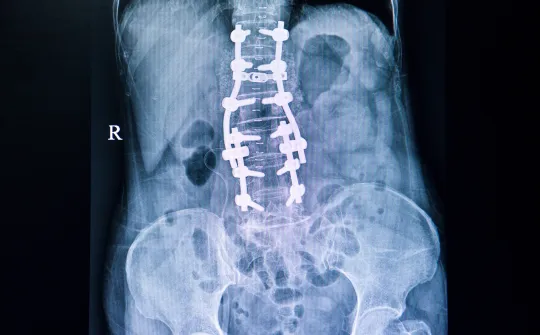
Laminectomy
A Laminectomy Can Alleviate Discomfort and Help You Regain Mobility
Pressure on your spinal cord from an injury, tumor, or age-related change can cause pain and difficulty in performing daily activities. When an injury occurs, painful bone spurs can develop along the edges of your vertebrae, resulting in joint deterioration and mobility issues.
When conservative treatment is not effective, the experienced spinal surgeons at Orthopaedic Specialists of Austin can perform decompression surgery, also known as a laminectomy, at our Leander, TX, practice. Undergoing this procedure can alleviate pain and help you regain your independence to improve your overall quality of life.

What is a Laminectomy?
A laminectomy is a common spinal decompression surgery that enlarges the spinal canal to relieve pressure on the spinal cord and nerve roots. This procedure is recommended when less invasive treatments, such as physical therapy or injections, have not been effective. During the procedure, the doctor will create space within your spinal canal by removing the entire lamina, the bony arch of the vertebrae that covers your spinal canal, as well any surrounding ligaments and bone spurs.
Bone spurs, also referred to as osteophytes, are bony growths that form along the edges of bones between joints and along your spine. They are often the result of injury or joint damage. When an injury occurs, your body can grow extra bone tissue to try and repair itself.

Who is a Good Candidate?
You may benefit from this surgery if you are suffering from a herniated disc, tumor, congenital defect, or age-related changes to your spine that are accompanied by:

Severe pain or muscle weakness
Affecting your lower extremities

Difficulty walking or standing
Or performing daily activities

Unchanged symptoms
Even after undergoing physical therapy or injections

A narrowing spinal canal
Thorough Examination
One of our doctors will perform a thorough examination and a series of x-rays and scans to determine the source of your back pain. If we diagnose stenosis and other conservative treatments have proven ineffective, your doctor will recommend surgery to address your symptoms. Before undergoing the procedure, your doctor will provide you with a list of pre-surgical instructions, such as medications and lifestyle habits to avoid, ensuring you achieve a smooth surgery and recovery.
How is the Procedure Performed?
During this procedure, the doctor will place you under anesthesia to ensure that you are comfortable. He will then make a small incision in the middle of your back to access the affected vertebrae. He will move skin, muscle, ligaments, and surrounding tissues in order to expose the lamina. Once he has a clear view, he will carefully remove the lamina and any bone spurs that are causing pain. If necessary, he will perform a spinal fusion to better stabilize the affected vertebrae. Once the procedure is completed, he will close the incision with stitches. The surgery generally takes between one and three hours to complete.
Risks and Benefits of Laminectomy
As with any surgery, there are risks involved, such as nerve damage and infection. However, having your procedure performed by one of our board-certified specialists will significantly reduce your risk for complications. Additionally, the benefits of undergoing this procedure considerably outweigh the possible risks. Patients who undergo a laminectomy can:
- Alleviate chronic back pain, numbness, and muscle weakness
- Maintain control over their bladder and bowel movements
- Enjoy walking and standing once again
- Perform daily activities without any assistance
- Experience renewed independence and a better quality of life

Laminectomy vs. Other Types of Spinal
Decompression Surgeries
While a laminectomy removes the entire lamina, there are other spinal decompression surgeries that are often performed in advance or in combination to help patients improve their mobility: